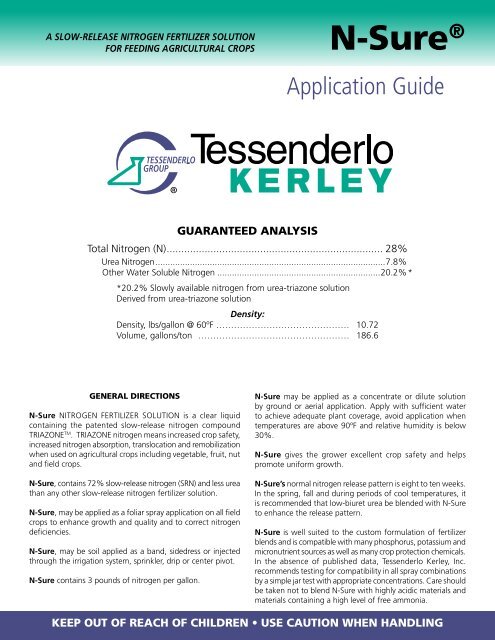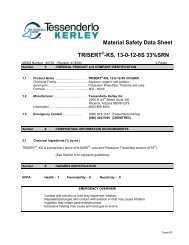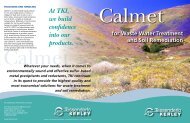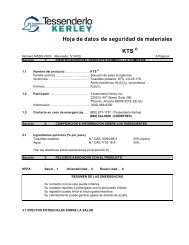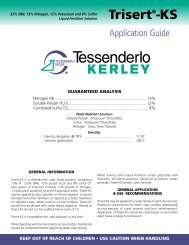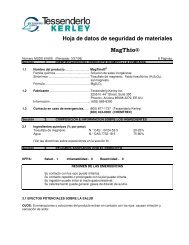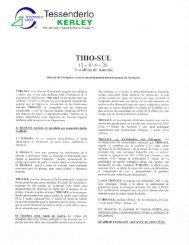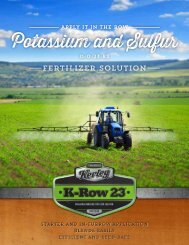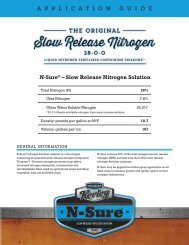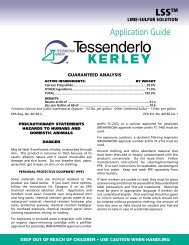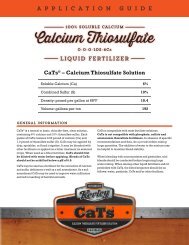N-Sure® - Tessenderlo Kerley
N-Sure® - Tessenderlo Kerley
N-Sure® - Tessenderlo Kerley
Create successful ePaper yourself
Turn your PDF publications into a flip-book with our unique Google optimized e-Paper software.
A SLOW-RELEASE NITROGEN FERTILIZER SOLUTION<br />
FOR FEEDING AGRICULTURAL CROPS<br />
N-Sure ®<br />
Application Guide<br />
GUARANTEED ANALYSIS<br />
Total Nitrogen (N).......................................................................... 28%<br />
Urea Nitrogen.............................................................................................7.8%<br />
Other Water Soluble Nitrogen...................................................................20.2% *<br />
*20.2% Slowly available nitrogen from urea-triazone solution<br />
Derived from urea-triazone solution<br />
Density:<br />
Density, lbs/gallon @ 60ºF………………………………………… 10.72<br />
Volume, gallons/ton… …………………………………………… 186.6<br />
GENERAL DIRECTIONS<br />
N-Sure NITROGEN FERTILIZER SOLUTION is a clear liquid<br />
containing the patented slow-release nitrogen compound<br />
TRIAZONE TM . TRIAZONE nitrogen means increased crop safety,<br />
increased nitrogen absorption, translocation and remobilization<br />
when used on agricultural crops including vegetable, fruit, nut<br />
and field crops.<br />
N-Sure, contains 72% slow-release nitrogen (SRN) and less urea<br />
than any other slow-release nitrogen fertilizer solution.<br />
N-Sure, may be applied as a foliar spray application on all field<br />
crops to enhance growth and quality and to correct nitrogen<br />
deficiencies.<br />
N-Sure, may be soil applied as a band, sidedress or injected<br />
through the irrigation system, sprinkler, drip or center pivot.<br />
N-Sure contains 3 pounds of nitrogen per gallon.<br />
N-Sure may be applied as a concentrate or dilute solution<br />
by ground or aerial application. Apply with sufficient water<br />
to achieve adequate plant coverage, avoid application when<br />
temperatures are above 90ºF and relative humidity is below<br />
30%.<br />
N-Sure gives the grower excellent crop safety and helps<br />
promote uniform growth.<br />
N-Sure’s normal nitrogen release pattern is eight to ten weeks.<br />
In the spring, fall and during periods of cool temperatures, it<br />
is recommended that low-biuret urea be blended with N-Sure<br />
to enhance the release pattern.<br />
N-Sure is well suited to the custom formulation of fertilizer<br />
blends and is compatible with many phosphorus, potassium and<br />
micronutrient sources as well as many crop protection chemicals.<br />
In the absence of published data, <strong>Tessenderlo</strong> <strong>Kerley</strong>, Inc.<br />
recommends testing for compatibility in all spray combinations<br />
by a simple jar test with appropriate concentrations. Care should<br />
be taken not to blend N-Sure with highly acidic materials and<br />
materials containing a high level of free ammonia.<br />
KEEP OUT OF REACH OF CHILDREN • USE CAUTION When HANDLING
SUGGESTED APPLICATION RATES<br />
Vegetable rate (q t s/a c r e) Time of APplication<br />
FOLIAR:<br />
Asparagus 4-8 At mid-fern development<br />
and repeat at 14 to 21<br />
day intervals.<br />
Beans 2-8 At early flowering and<br />
(Green & Lima)<br />
repeat in 7 to 10 days.<br />
Broccoli, 4-8 Prior to head formation<br />
Brussel Sprouts,<br />
repeat in 10 to 14 days.<br />
Cabbage & Cauliflower<br />
Carrots 4-6 When plants are 3 to 6<br />
inches tall. Repeat at<br />
three week intervals or<br />
as required.<br />
Celery 4-6 When plants are 8 to 12<br />
inches tall and repeat at<br />
10 to 14 day<br />
intervals.<br />
Corn (sweet) 2-8 When plants are 12 to 24<br />
inches tall, then at tassel<br />
emergence and repeat<br />
after pollination.<br />
Cucumbers, 4-8 Early flowering<br />
Melons, & Squash repeat at 10 to 14<br />
day intervals.<br />
Kale 4-8 When sufficient foliage is<br />
present.<br />
Lentils 4-6 Early flowering and<br />
repeat at 10<br />
to 14 day intervals.<br />
Lettuce 4-6 After thinning, then at<br />
early head formation and<br />
repeat at 10 to 14<br />
day intervals.<br />
Okra 4-6 At bud stage and repeat<br />
at 10 to 14 day intervals.<br />
Onions & Garlic 4-8 Mid-set development<br />
and repeat a 14 to 21<br />
day intervals.<br />
Peas 4-8 Early flowering and<br />
repeat in 10 to 14 days.<br />
Peppers 4-8 Early fruit set and repeat<br />
at 10 to 14 day intervals.<br />
Spinach 4-8 When sufficient foliage is<br />
present and repeat at 14<br />
to 21 days.<br />
Tomatoes 4-8 At full bloom and repeat<br />
(Process & Fresh)<br />
at 10 to 14 day intervals.<br />
Other crops 4-6 When sufficient foliage<br />
is present or at early fruit<br />
set. Try on a small area<br />
until more experience<br />
and trials have been<br />
completed to determine<br />
if higher rates are<br />
desirable.<br />
FERTIGATION<br />
Sprinkler Irrigation - Beginning at the 3rd to 4th leaf stage,<br />
apply 2 to 5 gallons per acre per application every 10 to 14<br />
days based on crop requirements.<br />
Drip Irrigation - Apply 2 to 5 gallons per acre per application 3<br />
to 6 times during the growing season as needed.<br />
Fruits & Nuts rate (q t s/a c r e) Time of Application<br />
FOLIAR:<br />
Almond, Filberts 4-10 At full leaf and repeat at<br />
Pecans, Walnuts<br />
early nut and expansion.<br />
Apples 4-6 Begin at first full leaf and<br />
apply as needed during<br />
the growing season.<br />
Blueberries 4-6 Early fruit set and repeat<br />
at early fruit color.<br />
Caneberries 4-6 Prior to fruit set.<br />
Cherries, Peaches, 4-6 Prior to fruit set<br />
Pears and Plums<br />
Citrus 4-10 Early bloom and repeat<br />
after fruit set.<br />
Winter Rate 4-10 Apply in mid-January and<br />
repeat as required.<br />
Cranberries 4-6 Hook stage and repeat<br />
after fruit set.<br />
Grapes<br />
Table 2-4 Prior to fruit set.<br />
Raisin 2-4 When sufficient foliage is<br />
present. Repeat as needed.<br />
Wine 2-4 When sufficient foliage<br />
is present. Repeat as<br />
needed.<br />
Olives 4-6 Early fruit development<br />
and repeat as needed.<br />
Strawberries 4-6 Early flowering and<br />
repeat every 14 days<br />
through harvest. Initiate<br />
fall application when<br />
new growth reaches 3<br />
inches in height.<br />
Other crops 4-6 When sufficient foliage<br />
is present or at early fruit<br />
set. Try on a small area<br />
until more experience<br />
and trials have been<br />
completed to determine<br />
if higher rates are<br />
desirable.<br />
N-Sure may be applied in a concentrate spray (50 to 100<br />
gallons of water) or dilute spray (200 to 400 gallons of water).<br />
Contact your local dealer on dilution rates less than 50 gallons<br />
per acre.<br />
FERTIGATION<br />
Sprinkler Irrigation - Apply 2 to 5 gallons per acre per application<br />
every 10 to 14 days based on crop requirements.
Drip Irrigation - Apply 2 to 5 gallons per acre per application 3<br />
to 6 times during the season when roots are actively growing<br />
as needed.<br />
Field Crops rate (q t s/a c r e) Time of ApPlication<br />
FOLIAR:<br />
Alfalfa 4-8 Apply after each cutting<br />
when sufficient foliage is<br />
present.<br />
Canola 4-8 Apply just prior to<br />
bolting.<br />
Corn<br />
Field 2-8 When plants are 12 to<br />
24 inches tall, then at<br />
tassel emergence and<br />
repeat after pollination.<br />
Seed 2-8 Before detasseling and<br />
repeat after pollination.<br />
Cotton 4-8 Early boll formation and<br />
repeat at 14 to 21 day<br />
intervals.<br />
Flax 4-8 Early boll development.<br />
Grain Sorghum 2-6 After pollination.<br />
Grass Seed 4-10 Seed head elongation.<br />
Production<br />
Hops 4-6 Before cone development.<br />
Peanuts 4-6 Early bloom and repeat<br />
at 14 to 21 day intervals<br />
until pods are filled.<br />
Potatoes 4-8 Tuber initiation and<br />
repeat at 10 to 14 day<br />
intervals until maximum<br />
tuber development has<br />
occurred.<br />
Rice 4-10 Panicle initiation. Repeat<br />
as required.<br />
Small Grains 4-8 Tillering through flag leaf<br />
emergence.<br />
Soybeans 2-8 Early pod formation and<br />
repeat in 14 to 21 days.<br />
Sugar Beets 4-8 10 to 12 leaf stage and<br />
repeat at 20 leaf stage.<br />
Sunflowers 4-8 When outer seeds start<br />
to fill, repeat in 10 to 14<br />
days.<br />
Tobacco 6-10 Plant bed stage to near<br />
maturity as needed to<br />
maintain crop growth<br />
and quality.<br />
Other Crops 4-6 When sufficient foliage<br />
is present or at early fruit<br />
set. Try on a small area<br />
until more experience<br />
and trials have been<br />
completed to determine<br />
if higher rates are<br />
desirable.<br />
FERTIGATION<br />
Center Pivot - Apply 3 to 5 gallons per acre per application as needed<br />
based on crop requirements.<br />
Drip Irrigation - Apply 3 to 5 gallons per acre per application 3 to 6<br />
times during the growing season as needed.<br />
Sprinkler Irrigation - Beginning at the 3rd to 4th leaf stage, apply 3<br />
to 5 gallons per acre per application every 10 to 14 days based on<br />
crop requirement.<br />
FOLIAR:<br />
CHRISTMAS TREES AND NURSERY STOCK<br />
RATE (q t s/a c r e) Time of Aplication<br />
4-6 As needed or at 14 to 21 day<br />
intervals.<br />
FERTIGATION<br />
Sprinkler Irrigation - Apply 2 to 4 gallons per acre per application<br />
every 10 to 14 days based on crop requirements.<br />
Drip Irrigation - Apply 2 to 4 gallons per acre per application 3<br />
to 6 times during the growing season as needed.<br />
Lawn Care Program<br />
Cool Season Grasses:<br />
Rates may vary from .5 to 1 pound of nitrogen per 1000 square feet<br />
in 4 to 5 applications at 8 to 10 week intervals for a total application<br />
rate not to exceed 3.5 to 4.0 pounds of nitrogen per year. In cool<br />
temperatures it is suggested that a portion of the nitrogen come<br />
from urea.<br />
Warm Season Grasses:<br />
Rates may vary from .75 to 1.0 pounds of nitrogen per 1000 square<br />
feet in 5 to 6 applications at 8 to 10 week intervals for a total application<br />
rate not to exceed 6 to 8 pounds of nitrogen per year. Rates<br />
of nitrogen and frequency of application may vary due to cultivar and<br />
accepted turf practices.<br />
FERTIGATION<br />
N-Sure may be injected during each irrigation at rates if 11 to 21<br />
fluid ounces (.25 to .50 pound of N) per thousand square feet. Rates<br />
may vary in accordance with the irrigation schedule. Use the lower<br />
recommended rate in more frequent watering.
MIXING PROCEDURES WHEN TANK MIXING N-Sure<br />
• Add 1/2 of total water spray tank<br />
• Start circulating material in tank<br />
• Add recommended amount of N-Sure or N-Sure based<br />
N-P-K fertilizer blend.<br />
• Add compatible micronutrients<br />
• Add flowable materials<br />
• Add emulsifiables<br />
• Add any soluble powders and/or water soluble fertilizers.<br />
All should be pre-dispersed in water before adding to the<br />
spray tank solution.<br />
• Complete filling of spray tank to desired volume and<br />
continue circulating prior to spray application<br />
• Flush all spray and nurse tank equipment after usage.<br />
If a lower amount of slow-release nitrogen is desired, the<br />
fertilizer blender has the option of mixing N-Sure and lowbiuret<br />
urea (46-0-0) together. The following chart provides<br />
the correct mixing ratios based on l pound of actual<br />
N. Sufficient water must be added to the following to<br />
dissolve the urea in the blend.<br />
TECHNICAL DATA INFORMATION<br />
PLANT NUTRIENT CONTENT<br />
Guaranteed Total Nitrogen (N), Wt. %..........................28.0 Min<br />
Urea Nitrogen (N), Wt. %.............................................. 7.8 Max<br />
Slow-Release Nitrogen (N), Wt. %................................20.2 Min<br />
Soluble Potash (K 2<br />
0), Wt. %........................................0.6 Typical<br />
TYPICAL DISTRIBUTION OF NITROGEN FORMS, % OF TOTAL N<br />
Slow-Release Nitrogen, Total...................................................72<br />
From TRIAZONE compounds...................................................67<br />
From Other N Compounds.......................................................5<br />
Urea Nitrogen.........................................................................28<br />
TYPICAL PROPERTIES<br />
Specific Gravity, 60°/60° F..................................................1.286<br />
pH… .....................................................................................9.5<br />
Salting-Out Temperature, °F....................................................


